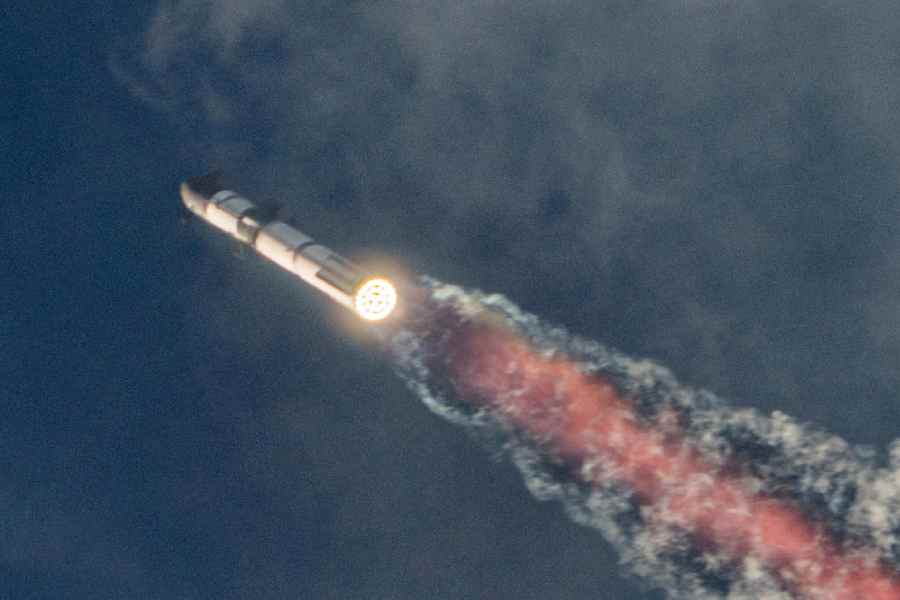Indian and US scientists have unravelled through a new study the post-launch loss of 38 of 49 satellites operated by a subsidiary of the US aerospace company SpaceX two years ago, attributed to a geomagnetic storm triggered by solar activity.
The study has corroborated earlier suggestions that the satellites were launched into a geomagnetic storm and were unable to recover from the storm’s adverse impact, IISER Calcutta researchers and their collaborators have said.
SpaceX had launched the 49 Starlink satellites — a constellation for Internet services worldwide — on February 3, 2022, into low-Earth orbit, their nearest point being 210km above the Earth. But 38 satellites slipped out of their orbits and burned up as they reentered the atmosphere within days.
SpaceX had said on February 8, 2022, that a geomagnetic storm had “significantly impacted” the satellites by warming the atmosphere and increasing the drag on them, causing them to reenter the atmosphere.
Now, the IISER researchers and their collaborators have used physics of the near-Sun and near-Earth space and computer simulations to reconstruct the full cascade of events that allegedly doomed the satellites. Their study was recently published in the peer-reviewed scientific journal Space Weather.
The study’s findings underline how even moderate geomagnetic storms stirred by solar activity can “conspire” with the physical design of satellites in low-Earth orbits to cause catastrophic losses, the scientists said.
“This was not (one of) what we would classify as killer storms — it was a moderate-intensity storm,” said Dibyendu Nandi, professor of solar physics at IISER who led the study.
“But the combination of launch timing, an intensifying storm, and the satellites’ design culminated in their loss.”
Email queries sent by this newspaper to SpaceX requesting its perspective and views on the IISER study’s observations have not evoked a reply yet.
Nandi, head of the Centre for Excellence in Space Sciences at the IISER, leads teams of research scholars engaged in tracking and predicting solar activity and other likely impacts on near-Earth space.
The researchers have noted that three coronal mass ejections — bursts of solar material into space — on January 29, January 31 and February 1 had hurled solar particles towards the Earth at speeds of up to 450km per second.
Their simulations showed how the magnetic fields associated with the incoming floods of particles interacted with Earth’s magnetic field, stirring up electric currents in the Earth’s ionosphere — a region of the upper atmosphere approximately 80km and higher.
The currents are known to heat the upper atmosphere levels causing the atmosphere to expand and thereby increasing the count and density of air molecules.
“The higher density increases the drag or friction that a satellite in low-Earth orbit will experience,” said Yoshita Baruah, a research scholar at the IISER and the study’s lead author.
The IISER team also used simulations to study how the increased matter density in the upper atmosphere is likely to have affected the satellites.
Their simulations involved a comparative analysis of how the increased matter density at altitudes between 210km and 434km above the Earth would have affected SpaceX’s Starlink satellites and a European Space Agency satellite named Swarm C, both in low-Earth orbit.
Their calculations indicated that the Starlink satellites may have experienced an altitude decay three times higher than what Swarm C would have. The scientists have attributed this higher adverse impact on Starlink satellites to their design attributes — specifically a relatively low mass-to-area ratio — also called a satellite’s “ballistic coefficient”.
“The lower the mass-to-area ratio value, the higher the drag on the satellite,” Baruah said. The ratio for the Swarm C satellite was three times the ratio for the Starlink satellite.
The findings suggest that the Starlink satellites had design attributes that may have subjected them to enhanced atmospheric drag relative to what the Swarm C satellite would have experienced, the researchers wrote in their study. In addition to their insertion into low-Earth orbit, the low ballistic coefficient of the Starlink satellites “may have further compromised their ability to recover” from the geomagnetic storm, they wrote.
Jonathan McDowell, an astrophysicist at the Centre for Astrophysics, Harvard University, who was not associated with the IISER study, told The Telegraph that the study seemed to have probed the event in greater detail than those attempted earlier, but came to similar conclusions as the earlier studies.
“I don’t recall seeing a detailed decay rate calculation for this incident before now,” said McDowell, who is also the editor of an internet newsletter, Jonathan Space Report, that provides technical details of satellite launches.
The study’s other coauthors are Souvik Roy and Suvadip Sinha from the IISER, Sanchita Pal and Denny Oliveira from the National Aeronautics and Space Administration Goddard Space Flight Centre, and Erika Palmeiro from Predictive Sciences, a private research entity in the US.











